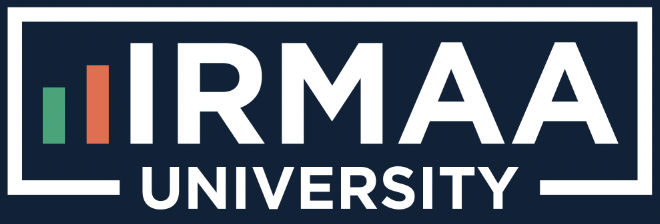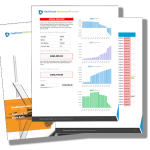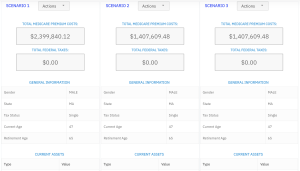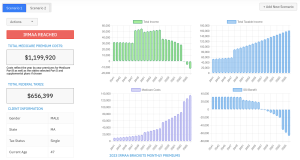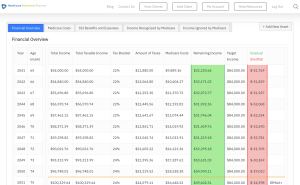You’re standing at a financial crossroads. In one direction, the path of Indexed Universal Life vs Roth Ira, glimmers with potential and promise. On the other side, lies the well-trodden road of traditional retirement planning options like social security or term life policies.
You’ve got some hard-earned money to invest in your future but uncertainty looms large – which route do you take? Would you venture down an unfamiliar path that could lead to unprecedented growth or stick with what’s tried-and-tested?
This post is your trusty compass for this journey. It’ll help demystify Indexed Universal Life vs Roth IRA, compare their unique features, explore tax implications, discuss benefits like lifelong coverage versus tax-free distributions.
Don’t sweat it, this choice might not be as tough as you think.
Understanding IUL and Roth IRA Policies
The financial world is packed with tools to help you prepare for retirement. Two of these, indexed universal life (IUL) insurance and the Roth Individual Retirement Account (IRA), offer unique benefits that can shape your retirement planning.
Defining Indexed Universal Life
An IUL is a type of permanent life insurance policy. Unlike term life policies, which only provide coverage for a specific period, an IUL offers lifelong protection.
This type of universal life policy does more than just give out death benefits tax-free though—it also accumulates cash value over time. This means part of your premium payments go into a separate account within the policy where it has potential growth based on market upswings in specific economic sectors.
IULs aren’t relying solely on stock market performance either—they come with minimum guaranteed earned rates to ensure some level of growth even during market downturns.
Defining Roth IRA
Roth IRAs work differently but share the goal of helping you secure future finances. They are essentially retirement accounts allowing individuals to save post-tax money for their golden years—money that grows tax-free as long as certain conditions are met.
A big perk here is when it’s time to start drawing down those savings after age 59½—the payouts from this retirement plan, including earnings, are typically free from federal income taxes since they were funded by post-tax dollars initially deposited into the account. Furthermore, unlike traditional IRAs or other types of pre-taxed retirements accounts, Roth IRAs don’t have required minimum distributions (RMDs), letting your account grow for as long as you like.
Key Differences between Indexed Universal Life and Roth IRA
When it comes to IULs and Roth IRAs, they play by different rules. Sure, you’ve got some wiggle room with your IUL premium payments, but when it comes to yearly contributions for a Roth IRA, that’s a whole other ball game.
Key Takeaway:
Indexed Universal Life (IUL) and Roth IRA are unique retirement planning tools. IUL, a life insurance policy, offers lifelong coverage, tax-free death benefits, and the chance to build cash value – it even guarantees some growth during market slumps. On the other hand, Roth IRA lets you stash away post-tax money that can grow tax-free under specific circumstances. It doesn’t mandate any minimum distributions.
Table of Contents:
Key Differences between Indexed Universal Life and Roth IRA
When planning for retirement, the choice of investment vehicle can significantly impact your financial future. Two popular options are Indexed Universal Life (IUL) insurance policies and Roth Individual Retirement Accounts (IRAs). Let’s compare their unique features to decide which one could be a more suitable choice for you.
Contribution Limits & Eligibility
IULs do not have any set contribution limits unlike Roth IRAs. You pay premiums as long as the policy is active. These premium payments build cash value over time based on market performance.
Roth IRAs, however, cap annual contributions at $6.5k or $7.5k if you’re 50 or older. This post-tax money grows tax-free inside your account with returns based on growth in specific economic sectors like stock markets.
In terms of eligibility, anyone can get an IUL irrespective of income level but single filers lose eligibility for Roth IRA contributions above an income threshold ($153k in 2023).
Tax Implications
IULs offer death benefits that payout surpasses estate tax limit without triggering federal estate taxes due to its life insurance nature whereas lump-sum distributions from a Roth IRA may attract federal estate taxes beyond the limit.
Premium payments made towards IULs come from pre-tax dollars while those made into a Roth IRA use post-tax money allowing it potential growth even during market downturn periods without additional taxation upon withdrawal after retirement age because earnings grow tax-free within these accounts. This benefit makes them attractive especially when compared against traditional forms where taxable events occur either during deposit or withdrawal stages.
Furthermore, both offer different advantages when it comes to distributions. While Roth IRAs provide tax-free income in retirement with no minimum distribution requirements, IULs allow policyholders to take loans against their cash value that are not taxable as they’re considered a return of premium payments and death benefits from an insurance policy.
Market Performance & Risk
Let’s talk about IUL.
Key Takeaway:
Thinking about retirement? Indexed Universal Life (IUL) and Roth IRA are both great options. IULs, different from Roth IRAs, don’t have contribution limits and anyone can get them no matter their income. They come with tax perks like death benefits that skip estate taxes. But, Roth IRAs do limit contributions while letting your post-tax money grow without any taxes.
Benefits of Indexed Universal Life
If you’re looking for a retirement plan that offers lifelong coverage, cash value accumulation, death benefits, and the potential for growth – an Indexed Universal Life (IUL) policy might be your answer. But what makes it so unique? Let’s dive into its many perks.
Lifelong Coverage & Cash Value Accumulation
IULs are a type of permanent life insurance which means they offer coverage as long as you live or until the policy matures – typically at age 121. This is in contrast to term life policies that only provide coverage for a specific period. IULs also build up cash value over time which can serve as an extra financial cushion if needed.
The premiums paid towards an IUL go beyond just securing a death benefit. A portion goes into accumulating cash value based on returns from specific economic sectors like stock indices without directly investing in them. So while traditional life policies give fixed interest rates on this accumulated amount, IULs take advantage of market upswings offering potentially higher returns.
You might think these sound similar to Roth IRAs with their post-tax money concept but here’s where they differ: The payout surpasses contributions tax-free after certain conditions are met with IULs unlike withdrawals from Roth IRAs after 59½ years old. You don’t need any bank account; simply pay premiums when due and let your money grow.
Growth Potential & Minimum Guaranteed Interest
We’ve mentioned how indexed universal policies link their growth to specific equity indexes rather than relying solely on company performance or declared rates by insurers like some other types of insurance do.
This offers significant potential growth during strong market performances but what happens during downturns? That’s another major plus point – IULs offer steady, non-equity earned rates as a safety net. They have minimum guaranteed interest rates that ensure account growth even in unfavorable market conditions.
And if you’re worried about joint filers losing out on benefits or those filing single having to bear higher costs – don’t. Unlike federal estate tax limits that affect married joint filers differently, this isn’t an issue with IULs.
Key Takeaway:
Indexed Universal Life (IUL) policies are more than just life insurance. They offer lifelong coverage, the potential for cash value accumulation and market-linked growth, all while providing a death benefit. IULs outshine traditional plans with their ability to harness market upswings for potentially higher returns, and still provide a safety net during downturns with guaranteed interest rates.
Benefits of Roth IRA
The power and potential of a Roth IRA retirement plan lie in its unique tax structure. Unlike traditional IRAs, with a Roth IRA, you contribute post-tax money.
Tax-Free Growth & Distributions
This feature lets your investments grow without worrying about income taxes. When it’s time to retire, all the distributions from your account are tax-free too.
What does this mean for you? Let’s break it down:
- You use post-tax money – This means that unlike other types of retirement accounts where contributions might be taxed upon withdrawal, with a Roth IRA everything you take out during retirement is yours to keep. That’s right; Uncle Sam doesn’t get his hands on any of it.
- No Required Minimum Distributions (RMDs) – Other forms like traditional IRAs force you to start taking money out at age 72 whether you need the cash or not. Not so with a Roth IRA which gives more control over when and how much income to draw each year after retiring.
Your investment isn’t tied directly to market performance either but rather grows based on non-equity earned rates such as mutual funds. These have been historically less volatile than stocks alone offering steadier growth especially during market downturns.
In addition, because these contributions are made using post-tax dollars there are no annual contribution limits allowing greater flexibility compared with many other plans that restrict how much can be invested each year.
A huge advantage here is also estate planning since inherited Roths aren’t subject to federal estate taxes up until certain high thresholds ($11 million-plus). Even if your payout surpasses the current federal estate tax limit, it’s only the amount over this threshold that might be taxed.
For many investors, the Roth IRA is a valuable tool in their retirement plan. It allows for steady growth during market upswings and protects savings during downturns by not relying solely on stock market performance.
The Role of Your Financial Advisor
Thinking about kicking off or shifting to a Roth IRA retirement account? Discuss your Roth IRA retirement account plans with a financial advisor. They’re there to give you advice tailored just for you.
Key Takeaway:
Roth IRAs are fantastic. Their true strength lies in their distinctive tax setup. You’re using money that’s already been taxed, so everything you pull out during retirement is completely yours – the government can’t lay a finger on it. There’s no need to stress about Required Minimum Distributions either, giving you full control over your income once you retire. And remember, market fluctuations don’t have to be scary; your investments will grow regardless.
FAQs
Is an IUL better than a Roth IRA?
Whether an IUL or Roth IRA is better hinges on your personal financial goals, risk tolerance, and tax situation. Both have their pros.
Which is better Roth IRA or index fund?
A Roth IRA isn’t directly comparable to an index fund since it’s a retirement account type while the latter is an investment vehicle. You can actually invest in index funds within a Roth.
What is the disadvantage of Indexed Universal Life?
The downsides of IUL include potential high costs, complex structure and risks tied to market performance which may affect cash value accumulation.
Can I roll my Roth IRA into an IUL?
Nope, you can’t directly roll over a Roth IRA into an Indexed Universal Life policy. However, you could withdraw from the former and put those funds towards premiums for the latter.
Conclusion
By now, you should have a solid grasp on the key differences between indexed universal life and Roth IRA. You’ve learned how both can be effective tools in your retirement planning strategy, each with its unique set of advantages.
IULs offer lifelong coverage while building cash value over time, providing death benefits tax-free to beneficiaries. They’re flexible and provide growth potential based on specific economic sectors without relying solely on stock market upswings.
Roth IRAs stand out for their post-tax contributions that allow for tax-free distributions in retirement – offering steady growth even if the market is down. There are no required minimum distributions (RMDs), making them an attractive choice for many investors.
Choosing between Indexed Universal Life vs Roth IRA doesn’t have to be daunting. It’s about aligning these options with your personal financial goals and risk tolerance levels – maybe even using both as part of a balanced approach!
Streamlining the Medicare Surcharge Calculation Process.
Our Healthcare Retirement Planner software is designed to streamline the retirement planning process for financial professionals. By providing an efficient way to calculate IRMAA costs, our tool helps you save time and focus on other aspects of your clients’ retirement plans.
- Faster calculations: Our software quickly calculates IRMAA costs based on your client’s income and tax filing status, eliminating manual calculations and potential errors.
- User-friendly interface: The intuitive design of our platform makes it easy for financial professionals to input data and generate results with minimal effort.
- Data integration: Seamlessly integrate our calculator into your existing financial planning tools or CRM systems for a more streamlined workflow.
- Easy to Understand Reports: Export reports to easily share with your clients
- Tax and Surcharge Modeling: see how different types of income affects both taxes and your surcharges.
In addition to simplifying the calculation process, using our Healthcare Retirement Planner can also help improve communication between you and your clients. With clear visuals that illustrate how IRMAA costs impact their overall retirement plan, you can effectively convey complex information in an easily digestible format. This enables clients to make informed decisions about their healthcare expenses during retirement while ensuring they are prepared for any potential changes in Medicare premiums due to income fluctuations. To learn more about how our software can benefit both you as a financial professional and your clients’ retirement planning experience, visit the features page. Streamlining retirement planning processes can help financial professionals save time and resources, allowing them to focus on other areas of their clients’ needs. Automated calculation of IRMAA costs is the next step in streamlining this process even further.

Mark Has been working in the Medicare and IRMAA space for the past 8+ years. He is the architect of the leading Social Security and Medicare IRMAA software. He is also the Co-Founder of IRMAA Certified Planner and Healthcare Retirement Planner.
